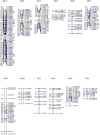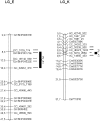First interspecific genetic linkage map for Castanea sativa x Castanea crenata revealed QTLs for resistance to Phytophthora cinnamomi
- PMID: 28880954
- PMCID: PMC5589223
- DOI: 10.1371/journal.pone.0184381
First interspecific genetic linkage map for Castanea sativa x Castanea crenata revealed QTLs for resistance to Phytophthora cinnamomi
Abstract
The Japanese chestnut (Castanea crenata) carries resistance to Phytophthora cinnamomi, the destructive and widespread oomycete causing ink disease. The European chestnut (Castanea sativa), carrying little to no disease resistance, is currently threatened by the presence of the oomycete pathogen in forests, orchards and nurseries. Determining the genetic basis of P. cinnamomi resistance, for further selection of molecular markers and candidate genes, is a prominent issue for implementation of marker assisted selection in the breeding programs for resistance. In this study, the first interspecific genetic linkage map of C. sativa x C. crenata allowed the detection of QTLs for P. cinnamomi resistance. The genetic map was constructed using two independent, control-cross mapping populations. Chestnut populations were genotyped using 452 microsatellite and single nucleotide polymorphism molecular markers derived from the available chestnut transcriptomes. The consensus genetic map spans 498,9 cM and contains 217 markers mapped with an average interval of 2.3 cM. For QTL analyses, the progression rate of P. cinnamomi lesions in excised shoots inoculated was used as the phenotypic metric. Using non-parametric and composite interval mapping approaches, two QTLs were identified for ink disease resistance, distributed in two linkage groups: E and K. The presence of QTLs located in linkage group E regarding P. cinnamomi resistance is consistent with a previous preliminary study developed in American x Chinese chestnut populations, suggesting the presence of common P. cinnamomi defense mechanisms across species. Results presented here extend the genomic resources of Castanea genus providing potential tools to assist the ongoing and future chestnut breeding programs.
Conflict of interest statement
Figures


References
-
- Hardham AR. Phytophthora cinnamomi. Mol Plant Pathol. 2005;6: 589–604. doi: 10.1111/j.1364-3703.2005.00308.x - DOI - PubMed
-
- Kamoun S, Furzer O, Jones JDG, Judelson HS, Ali GS, Dalio RJD, et al. The Top 10 oomycete pathogens in molecular plant pathology. Mol Plant Pathol. 2014;16: 413–34. doi: 10.1111/mpp.12190 - DOI - PMC - PubMed
-
- Anagnostakis SL. American chestnut sprout survival with biological control of the chestnut-blight fungus population. For Ecol Manage. 2001;152: 225–233. doi: 10.1016/S0378-1127(00)00605-8 - DOI
-
- Crandall BS, Gravatt GF, Ryan MM. Root disease of Castanea species and some coniferous and broadleaf nursery stocks, caused by Phytophthora cinnamomi. Phytopathology. 1945;35: 162–80.
-
- Jacobs DF, Dalgleish HJ, Nelson CD. A conceptual framework for restoration of threatened plants: the effective model of American chestnut (Castanea dentata) reintroduction. New Phytol. 2013;197: 378–93. doi: 10.1111/nph.12020 - DOI - PubMed
MeSH terms
LinkOut - more resources
Full Text Sources
Other Literature Sources

